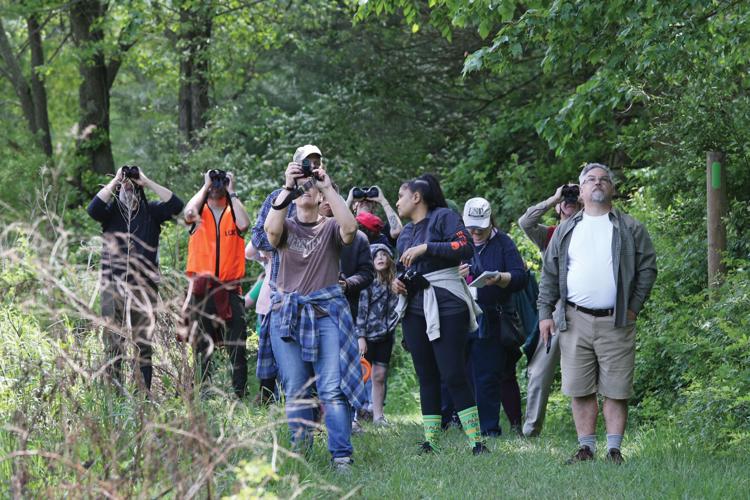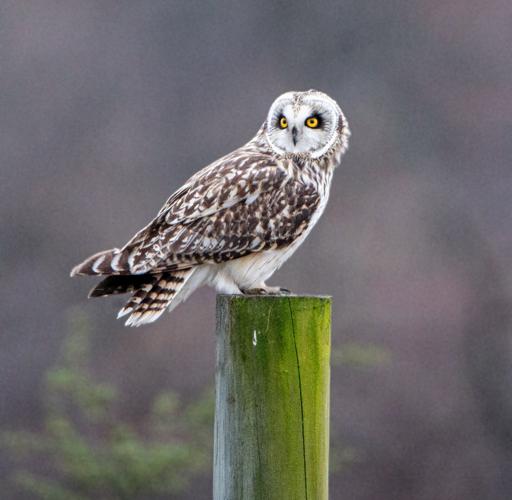Click here to read a list of tips for beginning birders, from the Lancaster County Bird Club.
On a recent Saturday afternoon in some fields north of Brickerville, 30 or so people — from little kids to seniors — hike along a rustic trail, occasionally standing still to listen for the song of a bird.
Some look at their cellphones to consult Merlin, a bird-call identification app.
Others heave large pairs of binoculars up to their eyes, searching for the thrush or warbler or oriole the app has suggested is nearby.
Birding in Lancaster County [photos]
The Lancaster County Bird Club leads birding field trips throughout the year. And there are plenty of great parks, preserves and game lands on which you can see a colorful range of birds. Here are some photos of activities during the May 11, 2024, World Migratory Bird Day at Middle Creek Wildlife Management Area near Stevens, along with some images of birds photographed there and around the county.
Suddenly, a sandhill crane flies overhead. The sight is met by appreciative “oohs” from the crowd on the ground.
Even at a distance, you can tell it’s a sandhill crane, the birding leader, Vince Pantanella of Manheim Township, tells the group, because it extends its neck as it flies. When herons fly, he adds, they scrunch their necks up.
This is the 86-year-old Lancaster County Bird Club, and the birding community it represents, in a nutshell. It’s passionate, knowledgeable, experienced birders, who know all about bird necks and bird calls, teaching neophyte birders how to tell a cedar waxwing from a tufted titmouse.
Click here to read a story from Balance magazine about Lancaster County birders and why they love the hobby, and about the Lancaster County Bi…
Here at the Middle Creek Wildlife Management Area, the bird club led two birding walks during a recent Migratory Bird Day event on a May Saturday.
Before the day was out, a whiteboard in the visitors center was filled with the names of species that bird club members helped novice birders spot and identify in the trees, from the telltale “witchity, witchity, witchity” song of a common yellowthroat to the “sweet, sweet, I’m so sweet” call of the yellow warbler.
“Birding really is a hobby that has a low barrier to entry,” says Ted Nichols II, of Annville, the president of the club, which was founded in 1937, making it one of the oldest bird clubs in the country.
“Most anyone who comes to one of our events, if they want to see a bird, I can take you outside and within 10 minutes, you’ll see a bird.
“The kindness and helpfulness of the people in this club — you come to a meeting and, just like a mother bird, there are birders who will put you under their wing and help develop an interest,” Nichols says.
“This is a wonderful community,” board member Kim Morelock of Mount Joy says. “I have made so many lifelong friends ... and travel partners” through birding.
Mike Epler of Middletown is one of those helpful birders. Epler, who is skilled at “birding by ear,” accompanies the club’s field trips, listening for birds, using Merlin (hosted by Cornell University’s Ornithology Lab) to record and identify sounds of birds not visible, and explaining birds’ coloring and songs for new birders in the group.
Birding is “something you can do on your own, you can do it in a group. It’s whatever you want it to be,” Epler says. He enjoys the “citizen science” of logging all species he sees on Cornell’s eBird app, through which many birders keep their “life lists” of species they’ve seen – and where the university collects data on where and when bird species are spotted.
READ: Donated bird-safe glass will soon grace 3 Lancaster County sites
Love for nature
Many Lancaster Bird Club members say they fell in love with birds, and nature in general, through Scouting or a nature-loving parent or grandparent when they were kids.
Barbara Hunsberger, of East Hempfield Township, was the former bird club president for 12 years, and is still on the board.
After learning about birds from her grandmother, Hunsberger later fell in love with the hobby when she and her husband took a naturalist’s noncredit class in birding.
“I’ve seen a real increase in interest in birding,” she says, “and it seems like there are a lot of younger people getting into it, starting with school-age kids.” She believes a lot more people embraced the hobby during the early months of the COVID-19 pandemic as a way to get outside.

Birders check out the wildlife at a May 11, 2024, World Migratory Bird Day birding outing — run by the Lancaster County Bird Club — at Middle Creek Wildlife Management Area near Stevens.
“The outdoors is really my therapy — my stress reliever” Hunsberger says.
Barry Grimecy, a retired retail project manager who lives on 7 acres in Quarryville that he’s turned into a preserve, says birding changed his life when he put a bird feeder in his backyard at age 9, in 1959. He joined the bird club in 1967.
“I’ve traveled to all the continents,” he says, and has seen thousands of bird species around the world.
“Three of my grown children are now birders,” Grimecy says, along with his grandchildren.
Morelock takes her grandkids birding, as well.
“It’s so good for your mental health,” she says. “There’s nothing I love more than going out into the woods, even if I’m by myself, it’s the most soothing ... it’s just the immersion in nature.
Nichols, who is in the military and also works in public relations for the federal government, got into birding when he was assigned to write about a group of birders visiting Fort Indiantown Gap a decade ago.
By the time he finished the assignment, he was hooked. He bought binoculars, and soon accompanied a birder friend to the Conoy Wetlands Preserve.
“The first bird I saw was a pronthonotary warbler down there,” he says. “Birders love warblers,”
Sandra Christian, who lives in Mount Joy, right near the entrance to Little Chiques Park, is a new member of the bird club, though not new to birding.
“I’ve been documenting the birds [in the park] for the past 10 years or so, and I’m up to 118 different species,” she says.

A pair of Eastern bluebirds stand on top of a nesting box at Noel Dorwart Park in East Hempfield Township April 22, 2024.
“It’s a healthy addiction, because it gets you out in nature and makes your body feel better,” she says.
Christian documents wildlife on a YouTube channel called “Birds and Critters of Little Chiques Park.”
“I started birding because of the great horned owl that nests here,” she says. And she has joined the bird club to find resources for protecting the birds of the park as a new housing development is planned nearby.
READ: North Museum’s bird collection thanks to generations of amateur naturalists
Club members
Nichols says the club, which has about 400 members, meets the second Thursday of each month — either at Middle Creek, the North Museum in Lancaster or Climbers Run Nature Center in Pequea — to swap stories of bird sightings and hear an expert talk about a topic affecting the birds.
The club also runs birding field trips — mostly, but not exclusively, on weekends — in between, Nichols says. Annual dues range from $10 to $40; you don’t have to be a member to attend meetings or most of the weekend field trips.

A common yellowthroat clings to a branch during World Migratory Bird Day at Middle Creek Wildlife Management Area in Stevens on Saturday, May 11, 2024
Nichols says his priorities as club president are to diversify the club membership, attract younger members and board members and form partnerships with other conservation-minded organizations in the region.
Nichols notes the club has many members from the Plain community, who are often the first to spot rare birds in the area because they spend so much time out in nature.
Each Canada goose that you see flying around in formation around Lancaster County these days…
Spiritual connection
On a damp, muddy Sunday on the trails and wet grass of the Millport Conservancy, Doug Anderson, an artist and retired teacher from nearby Lititz, leads a small birding group, ranging in age from 9 to 66.
Anderson got interested in birds through hiking with his family as a child, and through Audubon books from the library — since he was interested in both art and birds.
A red-winged blackbird flies by, trailing nesting material in its beak. The sound of a Baltimore oriole rings along the trail, but sightings of its orange feathers are elusive.
On the trail are Cooper Linde of Lancaster and his son Henry, 9, who say they love looking for waterfowl like wood ducks, kingfishers, ospreys and green herons.

A green heron stands on a branch at Farmingdale Trail in East Hempfield Township on Sept. 14, 2022.
Linde says his love for birding is a kind of spiritual connection.
“A clear way that God is speaking to us is through the birds,” Linde says.
“I feel like it’s a way to understand God and His interaction with humanity. ... You see that many times in the Bible. God speaks to humanity through birds, whether it be Noah and the ark with the doves and the raven, or ... where Jesus is baptized, the presence of a dove.”

Wildlife biologist Ryan Conner holds a common yellowthroat as he takes measurements and prepares the bird for banding during a World Migratory Bird Day event at Middle Creek Wildlife Management Area near Stevens, on Saturday, May 11, 2024.
Nichols says some species of birds are in trouble from environmental dangers. And the bird club stands ready to help protect them.
“It really is a warning to our future,” Nichols says. “Birds really are the canary in the coal mine as far as life here on Earth.”
“I found the Lancaster County Bird Club to be a great place to meet civilized and caring people,” Grimecy says. “And I find in a world today of chaos and dysfunction, that has a calming effect and it gives me faith in humanity.”
READ: There’s far more to feathers than meets the eye, naturalist tells bird club





 MARY ELLEN WRIGHT | Staff Writer
MARY ELLEN WRIGHT | Staff Writer










 AD CRABLE | Outdoors Columnist
AD CRABLE | Outdoors Columnist

